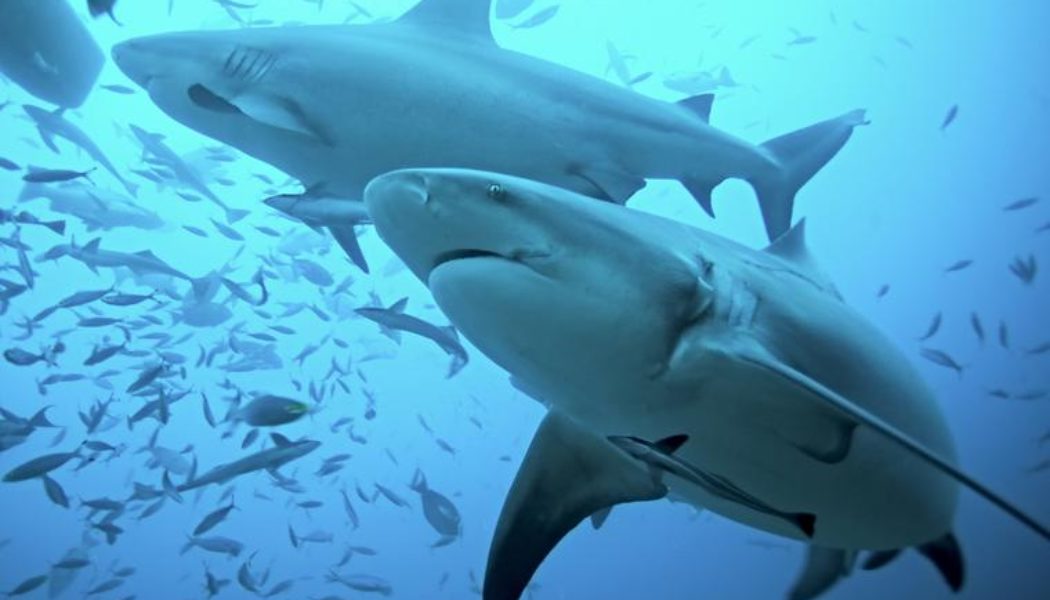
A Maryland colonist, in an effort to beat the heat of a hot summer day in 1640, waded into the cooling waters of St. Mary’s River for an afternoon swim, oblivious to the presence of a lethal predator lurking nearby.
“Scarcely had he touched the water” when a “huge fish” seized him, biting off “a large portion” of the man’s thigh, according to a contemporary account. He died from his wounds soon after.
As shark researchers, we’ve taken a keen interest in this little-known episode, originally chronicled in Latin by one of Maryland’s earliest and most respected Jesuit missionaries.
After carefully analyzing his account, we now believe it may well document the earliest recorded case of an unprovoked fatal shark attack of a recreational swimmer in North America.
Why share our findings with the Register? It’s “Shark Week,” for one thing. But more importantly, the story has a decidedly Catholic dimension. In fact, it was Richard’s knowledge of the Catholic faith that helped us unlock key clues we found in the historic record.
The Catholic context includes the victim: an indentured servant in St. Mary’s City, an early 17th-century English settlement of Catholic and Protestant colonists and Maryland’s first capital.
A year before, the unnamed man had converted to the Catholic faith, but whatever affection he might have had for the Catholic Church soon gave way to contempt and public mockery. We’re told he went so far as to grind up and smoke his “prayer beads,” likely made of dried fruits, berries or nuts.
We know these details thanks to a reputable Catholic source: Father Thomas Copley, an English Jesuit from a noble recusant Catholic family tasked with writing an annual letter to his superiors in Rome updating them on efforts to spread the faith in the new colony.
Finally, the date of the attack has special Catholic significance: We feel confident it took place on the Aug. 15 Solemnity of the Assumption of the Blessed Virgin Mary. The tragic irony of the irreverent servant’s death happening on that date, when the Jesuits traditionally blessed the local waters, would not have been lost on the Catholics of Copley’s day.
First, though, a bit more about us.
Kent is a retired bay ecologist and environmental historian who has a special interest in the biology, history, and shark activity of the Chesapeake Bay estuary. He first came across Copley’s account while researching the history of the Jesuits in the area.
Rich, a Jersey Shore native, is a physician, historian, author and a Mid-Atlantic investigator for the Global Shark Attack File, an online clearinghouse of information on “shark/human interactions” around the world. The data you’ll find on that website shows just how rare it is for a shark to attack a human without being provoked.
But it does happen: Rich’s 2016 book, Twelve Days of Terror, tells the dramatic story of the famous Jersey Shore shark attacks of 1916 that inspired the best-selling book and 1975’s Steven Spielberg blockbuster movie Jaws. A graduate of Georgetown University, where he majored in theology, Rich came across Kent’s brief notation of the 1640 episode while researching an iron cross the school owns that is believed to date to the 17th century.
The 1916 attacks in New Jersey, which left four people dead and another injured, provided the first widely accepted scientific evidence that sharks would hunt humans. So we immediately recognized the significance of a first-hand account written 276 years earlier of someone being bitten and killed in a brackish river by a “huge fish,” which we think was likely an 8-foot-long adult bull shark, for reasons we’ll explain below.
Maryland’s First European Settlement
If our analysis is correct, the 1640 attack would add to the list of “firsts” associated with St. Mary’s City.
The English community was the first European settlement in Maryland and served as the colony’s first capital from 1634 to 1695 until settlers relocated to Annapolis.
The two ships that brought the first colonists — the Ark and the Dove — landed at nearby St. Clement’s Island in 1634, 14 years after the Mayflower landed at Plymouth Rock and nearly 30 years after the founding of the first permanent English settlement in America in Jamestown, Virginia. The exact location of the original settlement was lost for some 400 years, until 2021 when archeologists using ground-penetrating radar located the remains of a fort in an empty meadow there about a half-mile from St. Mary’s River in southern Maryland.
It was there that Jesuit missionaries Andrew White, Father John Althman Gravenor, and Brother Thomas Gervase erected a large wooden cross in early March 1634. By March 25, the Feast of the Annunciation, the priests had procured a modest Native American dwelling to use for services. Under the rustic eaves of the colonies’ first Catholic chapel, Father White celebrated a Mass of gratitude — the first Catholic Mass in the original 13 English colonies, a day now recognized as Maryland’s “birthday.”
Father Copley joined them soon after, becoming the Jesuits’ superior in 1637.
In his role as chief of the “company,” Father Copley assembled the “Annual Letter(s) of the English Province of the Society of Jesus.” Written in Latin and addressed to the General of the Society in Rome, the report was meant to capture missionary accomplishments and notable events of the past year.
Filed away in the Jesuit archives in Rome, the annual letters contained valuable historical details, but two centuries would pass before they were translated and published in English, first in 1874 in “Narratives of Maryland:1633-1684,” and not long after that in “Records of the English Province of the Society of Jesus.” And shark researchers wouldn’t discover it until more than 100 years later.
‘Divine Vengeance’?
In his 1640 letter to Rome, Father Copley juxtaposed two recent conversion stories.
One illustrates God’s mercy; the man in question interpreted his survival from a catastrophic house fire as divine confirmation of his newfound faith. The other, relating the drama at the river, describes what Father Copley saw as a clear case of “divine vengeance.”
The rosary-smoker by then had become even “more sacrilegious.” How so? Father Copley doesn’t go into detail, but based on his wording, we suspect the lapsed convert may have mimicked the Jesuits’ water blessing.
If so, it proved a regrettable final insult, since the sound of splashing water is known to draw a shark’s attention.
The strike, when it came, would have been swift — and unsurvivable.
Father Copley wrote that “the unhappy wretch was in a short time hurried away from the living.” Here Father Copley can’t resist his own coup de grace, adding, “the divine justice bringing it about that he, who a little while before boasted that he had eaten up his ‘Ave Marias,’ should see his own flesh devoured, even while he was still living.”
Catholic Clues
Archival Catholic correspondence from that time can frustrate historians because the authors took care not to reveal too much. Anti-Catholic persecutions waxed and waned during this period, so scribes like Father Copley avoided identifying specific dates and locations or the names of new converts.
But for our purposes, however, we found plenty of data in Father Copley’s letter for a proper shark attack analysis: the season, the temperature, the geography of the area, the time of day, details about the man’s wound, and even a clue about the specific date the incident happened.
Was it really a shark that bit the man? If so, what dangerous species can be found 11 miles up a warm Mid-Atlantic estuary not known for sharks or shark-related injuries?
Since the word “sharke” was not yet formally recognized in the English or Latin lexicon, the author’s verbiage is similar to that used in the Book of Jonah where a “great fish” acts as an agent of God’s will. Calling the fish “huge” implies it made a major impression on eyewitnesses. Coupled with what we know about the size and severity of the bite, we believe the creature to have been about 8 feet long.
Unprovoked shark-human negative interactions most often involve a confused predator, a quick release, and non-life threatening injuries. With that said, the 1640 case describes one of those ultra-remote occurrences where a predator is acting in an intentional and ferocious fashion even with unfamiliar prey. The shark responsible for the 1640 incident seized a targeted and unsuspecting prey item, pounced, and attempted to drag and isolate the victim to deeper water. This strategy is typical of the bull shark.
Why Aug. 15?
Although no one wants to associate a grisly shark attack with the Blessed Mother, we believe Father Copley’s frequent references to a “vigil” most likely refer to the Solemnity of the Assumption, a feast that has special significance for the Jesuit order.
It’s on that day that Jesuit novices take final vows. Consistent with that tradition, St. Ignatius made his first vows on the Feast of the Assumption in 1534. Likewise, Jesuit Father John Carroll, was consecrated first U.S. bishop on the same date in 1790. Traditional Jesuit devotion to the Assumption feast also explains Father Copley’s confidence in using the vague “vigil” reference.
Equally important to the context’s embedded irony is the Feast Day’s customary blessing of coastal waters.
With that grasp of the timeline, the evidence suggested that the 1640 shark victim had made an initial commitment to the Catholic faith in the summer of 1639. That was when he would have acquired rosary beads at St. Mary’s City during the Assumption celebration.
As we head toward the height of summer and travel to coastal vistas, sharks will inevitably come to mind. The rarity of the serious 1640 occurrence, however, should only serve to put such happenings into proper perspective. The fatality at St. Mary’s City, like most other deadly shark-related encounters, is a case of being at the “wrong place at the wrong time.”
Regardless of Father Copley’s attribution of “divine vengeance” for the river incident, the veracity of his account appears unassailable. We believe it deserves recognition beside the Society of Jesus’ other numerous contributions to the field of natural science.





